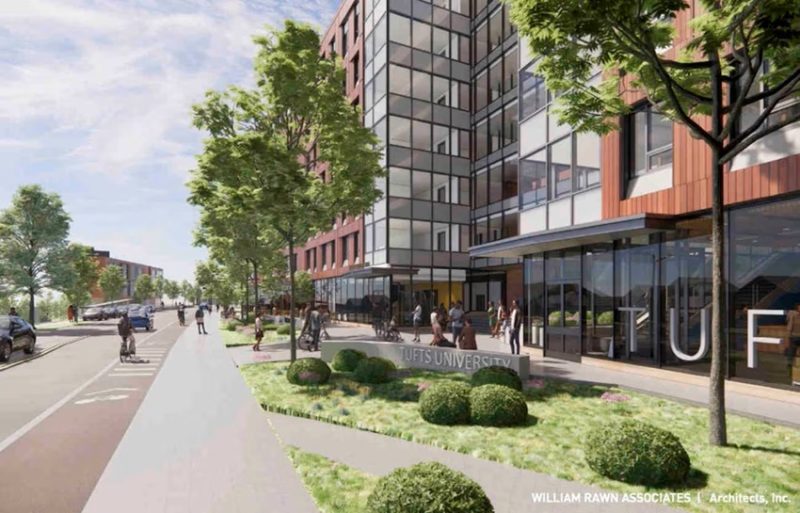Medford, OR – A proposed 10-story dormitory on Boston Avenue in Medford, Massachusetts, has sparked significant opposition from local residents who are raising concerns about its size, environmental impact, and potential effects on the character of their neighborhood.
Tufts University originally announced plans for a new dormitory in April 2021 as part of a $250 million initiative to expand its campus housing options. The university first proposed a seven-story residence hall for the site, but in September 2024, the plan was revised to include a taller, 10-story building. While Tufts has touted the project as a much-needed solution to student housing shortages, residents of the Medford Hillside neighborhood—where the dorm would be located—have raised a host of concerns.
A group of over 50 Medford residents signed a letter to the City of Medford’s Community Development Board in November 2024, urging a reconsideration of the building’s height. The letter argues that the 10-story structure is too large for the surrounding area, which is primarily made up of smaller homes such as triple-deckers and bungalows. Local residents fear the dormitory will disrupt the neighborhood’s scale and aesthetic, casting significant shadows over nearby homes and potentially leading to light pollution.
Adrienne Rae Landau, a 27-year resident of Brookings Street, called the proposed building “a monolith above our horizon.” She emphasized that the impact would be particularly detrimental to homeowners who have invested in the neighborhood and contribute to the local tax base. “What are all the ways such a monolith will impact the lives of people in these homes?” Landau wrote in the letter to the board.
Other residents, including Janey Tallarida of Charnwood Road, echoed concerns about the building’s massive size. “The size of that [six- or seven-story] building felt too large for the Hillside neighborhood, but at least was comparable to the adjacent parking garage,” Tallarida wrote. “This [10-story building] is a massive change. It’s vastly out of scale with a neighborhood consisting of triple-decker homes and small bungalows.”
Along with the building’s size, residents are concerned about the potential for increased traffic congestion and safety hazards. The new dormitory is expected to house 677 students, most of whom currently rent in Medford or neighboring Somerville. While Tufts argues that the new building will free up housing in the community, residents fear that it will also lead to more traffic on already congested streets.
In addition to vehicle traffic, there are concerns about pedestrian and cyclist safety. The proposal includes new crosswalks, sidewalks, trees, and a Bluebikes station to improve walkability, but local residents worry that these measures may not be enough to address the increased volume of people and vehicles.
The scale of the proposed dormitory is also seen as potentially disruptive to the environment and the daily lives of residents. Local residents are particularly worried about the shadowing effects the building will have on surrounding homes, as well as the potential for increased light pollution. The building’s height could alter the natural light conditions in nearby properties, diminishing residents’ quality of life.
“We will be living in the shadow of a massive building,” said Tallarida. “The city should hold Tufts accountable for considering the whole community and not just its own needs.”
The Role of the Dover Amendment
Another point of contention is the applicability of the Dover Amendment, a Massachusetts law that grants certain educational, religious, and agricultural buildings exemptions from local zoning laws. Some residents question whether the new dormitory qualifies for such an exemption, especially since the project now involves a for-profit development partner who will continue to manage and profit from the building long after construction is completed.
The letter from Medford Hillside residents calls for a full site plan review and a special permit, stating that the current proposal does not adequately address zoning concerns. The group also urged the Community Development Board to evaluate whether the building is truly necessary for the university’s educational mission, or if the project is being driven by financial interests.
Tufts University has acknowledged the concerns raised by residents but stands by its plans for the dormitory. Patrick Collins, executive director of media relations for the university, said that Tufts is “aware” of the objections and looks forward to working with the city and local community to address them.
Collins emphasized that the new dormitory is part of Tufts’ broader strategy to provide more on-campus housing for the university’s more than 6,000 undergraduate students. He noted that the building is designed to meet the city’s energy efficiency standards and includes plans for mixed-use development, transit-oriented design, and increased pedestrian accessibility, such as new crosswalks and retail options along Boston Avenue.
The university also argues that the dormitory will benefit the surrounding community by providing housing for students who would otherwise be renting in Medford and Somerville, thereby opening up rental units for non-Tufts residents.
As Tufts and the City of Medford move forward with plans for the dormitory, the debate over the building’s scale, impact, and long-term effects on the neighborhood continues to unfold. While Tufts remains optimistic about the project’s potential benefits, many residents feel that the size and scope of the proposed building are out of proportion with the surrounding community.
The Medford Community Development Board is expected to review the proposal in the coming months, and the outcome of that review will determine whether the project moves forward as planned or undergoes further revisions. For now, local residents remain vocal in their opposition, urging the city to carefully consider the broader implications of such a large-scale development in their neighborhood.

